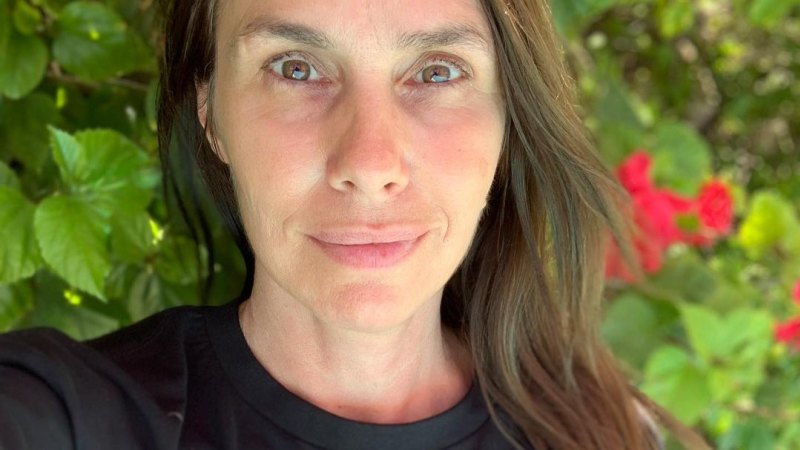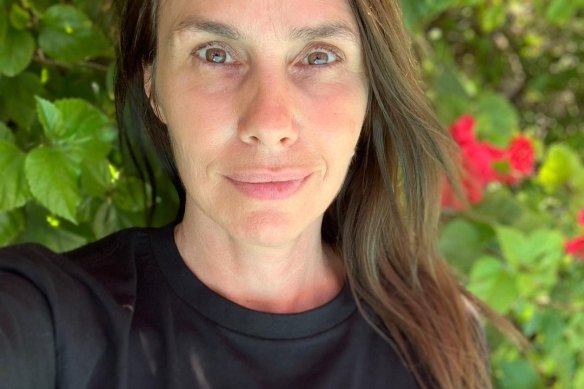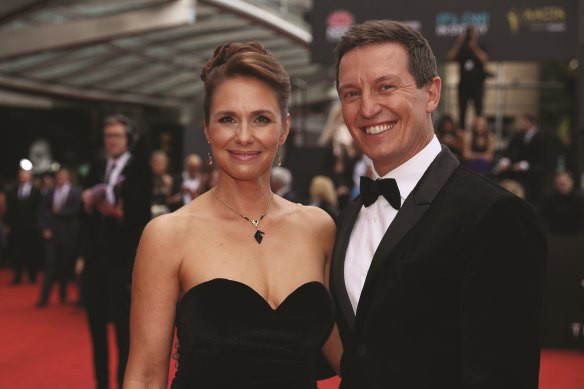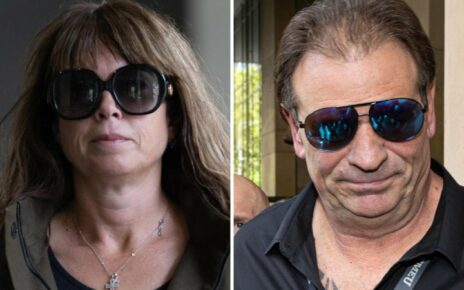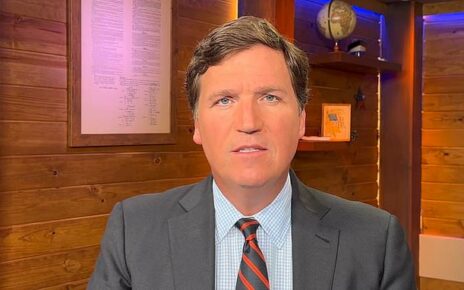Save articles for later
Add articles to your saved list and come back to them any time.
When actor Tasma Walton told the origin story of the black swan on Albert Park and Na’arm’s bay waters she was addressing an audience far removed from the TV productions that made her famous on Australia’s small screens.
In the formal setting of the Federal Court, Walton told of a white swan searching for somewhere to lay its eggs.
Tasma Walton in a recent photo she posted on Instagram.Credit: Instagram
In her tale, the swan finds suitable wetlands, and lays her clutch of eggs but is disrupted by an irate bunyip who launches from the water to declare “he doesn’t want any families of swans on his wetlands.”
The swan challenges the bunyip and a fight erupts. The swan, “fierce enough as a mum to win the fight”, is stripped of her feathers in the dust-up and her beak becomes red with the bunyip’s blood. Beaten, the bunyip takes off and a sympathetic crow then gifts the swan some its own feathers, thus “the white swan becomes a black swan.”
It was just one of the “unusual stories” Walton recalled being told by her grandmother in her evidence as the first witness in a native title application covering 13,000 square kilometres of Victoria’s coast from Werribee to Wilsons Promontory.
Walton spoke for about an hour, providing evidence of her personal history, the best knowledge of her ancestry and how she came to identify specifically as Bunurong.
Two more of her grandmother’s supposedly culturally laden and instructive yarns were about a baby whale, containing similar parabolic tones to the swan tale, and mermaids being involved in the 1967 disappearance of former prime minister Harold Holt.
The unfortunate social media response to news reporting of the case focused on the colourful elements of Walton’s testimony and attracted racist commentary, including threats to her and her family, the court heard. The fallout resulted in an application from a distressed Walton to withdraw from the legal case, overshadowing more consequential evidence heard at other times during the week.
The evidence heard over four days touched on more than 25 years of research for formal recognition of a connection to Country for the Boon Wurrung Land and Sea Foundation – a prolonged stoush over ancestry with rival Indigenous organisation, the Bunurong Land Council Aboriginal Corporation. The testimony also gave a horrific account of the violence and enduring harms wrought by European colonisation on the cultures and kinfolk of the area’s First Peoples and Tasmanian Aboriginals.
Trying to unscramble the effects of colonisation is a distressing and painstaking endeavour, particularly for communities that bear the brunt of that terrible history.
Concerning the Boon Wurrung native title application specifically, the court heard of the violent abduction and human trafficking of local and Tasmanian Aboriginal girls and young women to European sealers and whalers in the early decades of the 1800s.
The ancestors of four of these young women, all stolen and traded to violent “Straitsmen” of the Furneaux Islands, are at the centre of the tension over the native title application.
The First People of this area are known to have largely included the Boonwurrung – spelled in Western form as Boonerwrung, Bunurong, Boonorong and Boon Wurrung – among about 60 other variations. The word Boon means “to speak or with the lips” and wurrung means language of the people. All spelling variations refer to the one recognised traditional owner nation or tribal estate “at sovereignty”, or before European invasion.
The Boon Wurrung are part of the larger Eastern Kulin nation, a confederacy of tribes made up of the Boon Wurrung, and the Woi Wurrung Wurundjeri, Taungurong, Dja Dja Wurrung and Wathaurong peoples.
The Boon Wurrung application – lodged in June 2020 – lists three women as the apical ancestors of the traditional owners “at sovereignty”, those at the uppermost tip of the known family tree: Marjorie Munro, Ann Munrow and Louisa Briggs, who as a girl was abducted from a beach at Point Nepean about 1833 and trafficked to sealers across Bass Strait.
The application includes a primary account from an elderly Louisa Briggs, who said in a 1923-24 interview with researchers from the University of Sydney, that she was taken “in a little sailing boat” to Tasmania and “lived in the ighlands” [sic] there”.
Briggs – who was the granddaughter of Marjorie Munro – eventually married into a polygamous relationship with Anne Munrow and their husband, John Briggs, a Tasmanian Aboriginal man, according to the expert research before the court.
In 1858, Louisa, Anne and John returned to the women’s traditional Country and lived in a number of locations around the East Kulin nation on the mainland, including Beaufort, in Victoria’s central highland goldfields, and near Violet Town, north-east of Melbourne, until in 1871 their family settled at the Coranderrk Aboriginal station, near Healesville on the northern outskirts of Melbourne.
Tasma Walton with her partner Rove McManus in 2017.Credit: Getty Images
In their application to the Federal Court as part of the native title claim, the Boon Wurrung group challenges heritage of three other women said to have been abducted from the “Port Phillip area” during the early 1800s – Elizabeth Maynard, Eliza Nowan and Jane Foster.
Rival group, the Bunurong Land Council Aboriginal Corporation (BLC), rely upon the Bunurong heritage of these apical ancestors to claim their rights to Country. In a return of serve, the BLC claim Louisa Briggs was not Bunurong/Boon Wurrung, but a Tasmanian Aboriginal.
Under the Native Title Act there can be only one determination of native title for a particular area. If a person with native title rights and interests does not become a party to this application, there may be no other opportunity for the Federal Court, in making its determination, to consider those native title rights and interests of the excluded party relating to the “Decision Area”.
Complicating matters further is the position of the Victorian state government’s Aboriginal Heritage Council, which recognises the authority of the BLC under Victoria’s Aboriginal Heritage Act. However, the state also already officially recognises Louisa Briggs as a Boon Wurrung/ Bunurong apical ancestor.
In 2019, the Boon Wurrung group unsuccessfully challenged in the Supreme Court, the Heritage Council’s decision to award registered-status to BLC. Upon having its native title application accepted by the Federal Court in 2020, principle Boon Wurrung applicant Dr Carolyn Briggs made pointed public remarks about state government intimidation and interference over “who owned the traditional rights over Boonwurrung Country”.
“We feel the state is attempting to hamper and sabotage our claim by bankrupting our community by appointing an interstate group as a recognised Aboriginal party over our country – and advising local government and corporates not to associate with us. We will not be bullied,” Briggs said at the time.
“By lodging this claim in the Federal Court, we can be assured the claim will be determined on the facts rather than the prejudices of particular interest groups and public servant fiefdoms.”
Yet another hurdle for the Boon Wurrung group presents in the form of the Wurundjeri Woi-wurrung Cultural Heritage Aboriginal Corporation – the state-registered organisation that is the traditional neighbour and ally of the Boon Wurrung/Bunurong – which says it opposes the application because it overlaps with areas currently within the Wurundjeri Corporation’s area of registration under the state Aboriginal Heritage Act.
However, in an illuminating exchange between Justice Bernard Murphy and former BLC heritage officer Robert Ogden on Tuesday, it became apparent not all members of the BLC witness group share the position that Louisa was not of Boon Wurrung/Bunurong heritage.
Murphy: “You’re a named party in this application, you’re one of the Bunurong respondents … do you accept that Carolyn Briggs is a descendent of Louisa Briggs and a Bunurong person?”
Ogden: “Yes.”
Murphy: “But your counsel in this case is running a case which says she is not.”
Ogden: “Well, I accept her as that. It’s not for me to decide whether she is or whether she isn’t … I accept that she is…”
In light of their own witnesses’ testimony, an emergency meeting of BLC directors was called on Wednesday night to consider the group’s position.
What’s left is a complicated trail of ancestry for the court to unpick and a broken Walton, who has been given time to decide if she wishes to push ahead with her part in a storyline with more twists and turns than any scripted television drama.
The Morning Edition newsletter is our guide to the day’s most important and interesting stories, analysis and insights. Sign up here.
Most Viewed in National
From our partners
Source: Read Full Article
